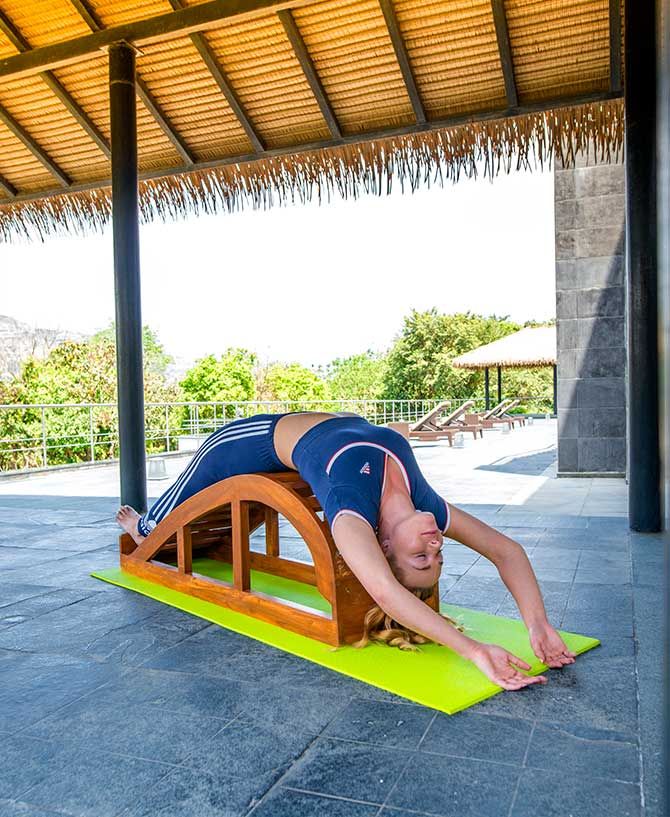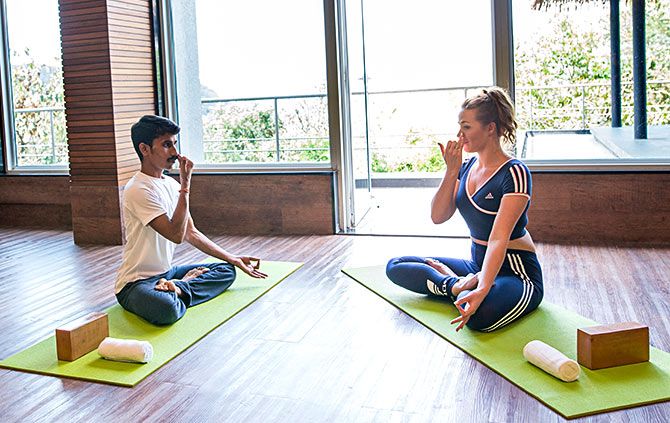Set aside a few minutes from your busy schedule and try these postures.
Our body systems and physiological processes get activated when there is an acute physical emergency.
The stress response, involves a coordinated, but complex system of physiological responses that are called upon as needed.
Such responses are beneficial at times because they provide us the immunity and prepare us to deal with potentially dangerous or threatening situations and we call this as an essential stress or 'eustress'.
However, health is affected when physiological reactions are sustained, as can happen in response to ongoing stress.
Stress induced disorders
If the cumulative reactions of continued stress are chronic or if they frequently exceed normal ranges, they can lead to premature wear and tear on the body, in much the same way running a machine continuously will eventually cause wear and tear on it.
Continued stress contribute to increased sympathetic functions and raises the blood pressure which eventually causes too much load on the heart resulting in heart failure.
Also, someone exposed to high levels of the stress hormone cortisol might become vulnerable to infection or disease because of weakened immune system functioning.
The most common stress induced disorders are hypertension, hyper cholesterol, diabetes, obesity, cancers, IBS, peptic ulcers, migraine, etc.
Yoga is a mind-body practice that combines physical poses with controlled breathing and meditation. Some of the yoga practices help one to reduce stress. Read on...
Eka pada pranamasana

Benefits
- This pose improves concentration, balances the body and mind thus providing a calming effect on the overall systems.
- The yogic tree pose has a direct influence on the third eye (Ajna Chakra) which is also responsible for the pituitary and pineal glands thus helping to balance out the hormone system in the body.
How to do it:
- Stand erect; keep the feet together.
- Fold the right leg and place the foot on left inner thigh and the toes of right leg should point downwards.
- Extend your arms above your head or at chest level. Inhale and try to make Namaskar mudra with your palms.
- Balance the pose as long as you can because balancing is utmost important in Tree pose.
- Try to make your spine straight and feel the stretching from toes to fingers.
- With deep exhalation bring your arms and leg down.
- Repeat the same with left leg. It completes one round.
Pawanmuktasana
Benefits
- It relieves the stress on the spinal nerves relieving physical stresses and massages the internal organs.
- It helps to make the spine strong and flexible.
- Helps normalise the blood-glucose levels and stimulates the internal organs.
How to do it
- Begin by lying on your back, with your legs and arms extended.
- As you exhale, draw both of your knees to your chest.
- Clasp your hands around your knees.
- While holding only your right knee, release your left leg and extend it along the floor. Hold this pose for 30 seconds to one minute.
- Draw your left knee back in towards your chest and clasp your hands around both knees again.
- While holding only your left knee, release your right leg and extend it along the floor. Hold this pose for the same amount of time.
- Finally, draw both knees to your chest.
Setu bandasana

Benefits
- This asana gives a good stretch to the chest, neck and spine.
- It calms the brain, reducing anxiety, stress and depression.
How to do it
- Sit on the bridge prop and place both your heels on edge for support of your heels.
- Slightly flex your knees and hold the wooden edge side of your hip by your hands.
- Use your elbows for support and while inhale lie on the wooden bridge slowly.
- Once you are comfortable release your hand support and stretch your both hands above head.
- Gently close your eyes, keep normal breathing and feel the stretch on your back.
- Hold the posture as long as comfortable then place the hands on the side of waist on the wood.
- Flex your neck forward and then release in a reverse manner.
- Do forward bend as a counter pose with knee straight.
Pranayama
Breathing is a vital process which starts at the time of birth and stops at the death. All the metabolic processes require oxygen.
Oxygen is life, a vital force. This vital energy is called Prana. The process of controlling the Prana is called Pranayama.
So Pranayama is the science related to vital force supplying energy and controlling the body mind complex
Nadi shuddhi pranayama

The exercise of the Nadisuddhi pranayama produces optimum function to both sides of the brain.
The left side of the brain is responsible for logical thinking and the right side is responsible for creative thinking. This practice balances sympathetic and para sympathetic nervous system.
How to do it
- Sit comfortably with your spine erect and shoulders relaxed. Keep a gentle smile on your face.
- Place your left hand on the left knee, palms open to the sky or in Chin Mudra (thumb and index finger gently touching at the tips).
- Place the ring finger and little finger on the left nostril, and the thumb on the right nostril. We will use the ring finger and little finger to open or close the left nostril and thumb for the right nostril.
- Press your thumb down on the right nostril and breathe out gently through the left nostril.
- Now breathe in from the left nostril and then press the left nostril gently with the ring finger and little finger. Removing the right thumb from the right nostril, breathe out from the right.
- Breathe in from the right nostril and exhale from the left. You have now completed one round of Nadi Shudhi pranayama.
- Complete 9 such rounds by alternately breathing through both the nostrils.
Brahmari pranayama

Brahmari is effective in instantly calming down the mind. It is one of the best breathing exercises to free the mind of agitation, frustration or anxiety and get rid of anger to a great extent.
A simple technique, it can be practiced anywhere -- at work or home and is an instant option to de-stress yourself.
It works on calming the nerves and soothes them especially around the brain and forehead. The humming sound vibrations have a natural calming effect.
How to do it
- Sit up straight with your eyes closed. Keep a gentle smile on your face
- Observe the sensations in the body and the quietness within and place your index fingers on the cartilage between the cheek and the ear such that it closes the ears
- Take a deep breath in and as you breathe out make loud humming sound like a bee.
- You can also make a low-pitched sound but it is a good idea to make a high-pitched one for better results
- Breathe in again and continue the same pattern 3 to 4 times.
The author, Dr Manoj Kutteri, is wellness director, Atmantan, a wellness resort and health centre based in Mulshi.
All images: Kind courtesy Atmantam











